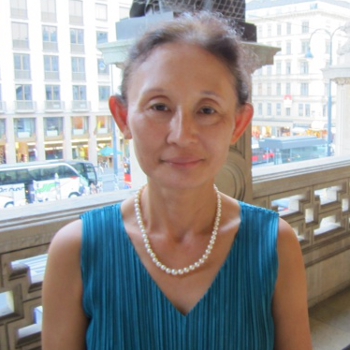“My theater is a formal theater” says the American director Robert Wilson in the program of his latest opera production, La traviata, in Linz, dedicated to the memory of Gerard Mortier. Wilson’s productions essentially have the same formula: a bare stage devoid of props save for an occasional bench, platform, and bed is typical, and lighting is a critical and integral part of the production. Characters often wear heavy white makeup and engage in slow-motion gestures. Small hand movements or facial expressions are used to convey mood and emotions. There are no sudden movements nor outbursts; every piece of action is carefully calculated and deliberately executed.
This new Traviata, premiered in September, followed the predictable pattern almost to a tee. During the prelude, we saw a sliver of light across the bottom of an otherwise dark stage as the curtain rose to reveal an abstract sculpture hung and illuminated in mid air. This sculpture slowly rose and disappeared by the end of the prelude. The Act I party scene had Violetta center stage, flanked by lines of men and women in formal wear. Partygoers would hop, skip, and wobble their heads to indicate their tipsy and merry state. Pointed white sticks of various length floated in the air, increasing in size as the act progressed.
Violetta and Alfredo’s love nest in Act II was no more than a bare floor with bushes made of thin long sticks moving about. Flora’s party featured lamps of various shape from the ceiling with masked chorus illuminated in red. Men wearing bulls’ horns enacted the gypsy dancing. The red disappeared as Alfredo publicly humiliated Violetta, who sat on a bench in front with her back to the audience to indicate her distress. Act III had a chaise-like bed and a small illuminated window, Violetta’s only connection to the outside world. The final scene lit Violetta in death with her upper body tilted one side with arms stretched and a faint smile on her face, while other characters were mere dark silhouettes in the back. Wilson has said that Violetta died with the word “joy” on her lips; hence the light and smile at the end of her sacrifice.
Wilson readily acknowledged the influence of traditional Asian theater, especially Japanese Noh with its masks and slow, deliberate movements. It was therefore fitting that the evening’s performance featured a young Japanese conductor and that two of the three principal singers were Asian. Takeshi Moriuchi elicited delicate and sensitive playing from the Linz Bruckner Orchestra, emphasizing long lines in Verdi’s score. The music often seemed to breathe with the singers on stage, with webs and flows of emotions carefully managed. The volume was sometimes reduced deliberately, with the singers almost whispering the words.
Japanese soprano Mari Moriya, making a role debut as Violetta, sang the challenging role like an experienced singer. Her voice had both beauty and clarity, free of vibrato, and she executed the tricky Act I coloratura passages with smooth elegance and hit the high notes cleanly. The dynamic range of her voice was astonishing, as she gained strength and confidence in Acts II and III. Her face, painted white with exaggerated eyes, maintaining a stoical look save for occasional stylized expressions of emotions, was a haunting presence throughout. Her death as an inevitable end came as the orchestra quietly played the last notes, her tilted body and face with a faint smile being the only image on stage. It had a tremendous emotional impact. Wilson’s “less is more” approach to opera production had the power to touch a raw nerve, with singers’ minimal gestures expressing their deepest emotions as the orchestra told the rest of the story.
Violetta’s lover Alfredo was sung by South African tenor Jacques le Roux. After a bit of a rough start, he quickly gained the necessary brilliance and power as an immature but ardent young man. Korean Soho Chang was a smooth and elegant Germont père, although his tendency to shift back and forth between sotto voce and regular voice in the same phrase, with coordination with the orchestra, seemed a little excessive, and did not contribute to a deeper interpretation of the character. Smaller roles were well sung and acted, with the whole ensemble gamely and expertly meeting the physical demands of Mr Wilson’s production.
While many operagoers may feel put off by Mr Wilson’s stylized and formal approach, this new Traviata once again showed that elaborate staging is not always necessary for a successful performance. Effective use of lighting and minimal gestures could sometimes convey the deepest of human emotions to bring out the essence of the opera.




